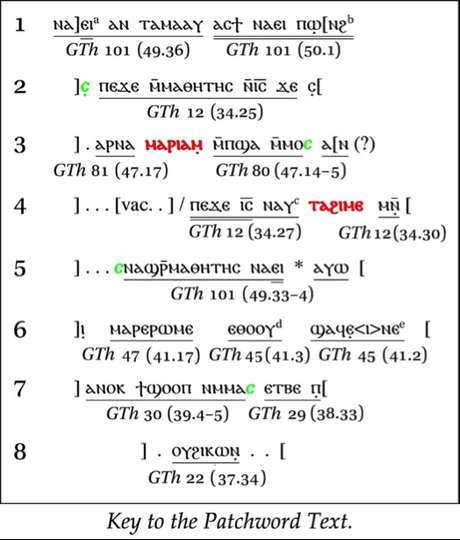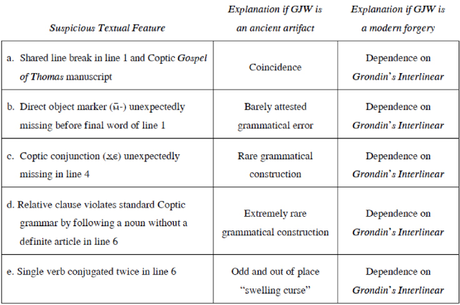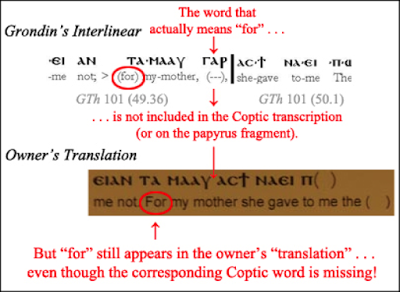[PDF of this blog post available here]
For nearly three years, there has been considerable controversy and confusion about whether a business-card sized papyrus fragment dubbed the Gospel of Jesus’ Wife is an authentic ancient artifact or not. The current scholarly consensus already holds that the fragment is forgery. In addition, a recent development has confirmed that the Gospel of Jesus’ Wife is a forgery created using a specific internet edition of the Gospel of Thomas. It seems that the Gospel of Jesus’ Wife forgery debate has finally come to an end.
The Patchwork Forgery Theory
Shortly after Professor Karen King of Harvard Divinity School unveiled the Gospel of Jesus’ Wife at an academic conference in September 2012, a scholar named Francis Watson pointed out that the text appeared to be little more than a “patchwork” of words and short phrases culled from the lone surviving manuscript of the Gospel of Thomas in Coptic (a form of the ancient Egyptian language). Building on the work of Professor Watson and other scholars (including Alin Suciu and Hugo Lundhaug), I soon suggested that the Gospel of Jesus’ Wife could have been created by someone with limited knowledge of Coptic using a specific modern edition of the Gospel of Thomas prepared by Michael W. Grondin.
As I researched the textual relationship between the Gospel of Thomas and the Gospel of Jesus’ Wife, I began to collect evidence that ultimately convinced me that the Gospel of Jesus’ Wife was indeed prepared by someone relying directly on the PDF edition of Grondin’s Interlinear Coptic/English Translation of The Gospel of Thomasposted online in November 2002. I discovered that the textual similarities between the Gospel of Jesus’ Wife and the Gospel of Thomas were overwhelming. Basically, to create the Gospel of Jesus’ Wife, all a forger would have had to do was “cut and paste” text from the Gospel of Thomas, switch a few masculine pronouns to feminine (a single letter change in Coptic), and place two key Coptic words (meaning “Mary” and “my wife”) into the “patchwork” text to create its “sensational” content. The only other change that would have been needed was the simple deletion of the two-letter Coptic word meaning “not” in line 5.
The figure below illustrates the relationship between the Gospel of Jesus’ Wife and the Gospel of Thomas. It presents the Coptic text of the Gospel of Jesus’ Wifepapyrus fragment: text that appears to have been copied verbatim from the Gospel of Thomas is underlined(double underlined if it might easily have differed). Parallels to the Gospel of Thomas (with their manuscript page and line numbers in parentheses) are noted beneath the Coptic text. The Coptic pronouns that appear to have been changed from masculine to feminine are printed in green italics. The Coptic words not copied verbatim from the Gospel of Thomas that look like they have been specifically inserted into the “patchwork” text are printed in bold red: “Mary” (line 3) and “my wife” (line 4).

Every single line of the Gospel of Jesus’ Wifecontains one or more snippet(s) of text found in close proximity to each other in the Gospel of Thomas; indeed, for each individual line, the relevant snippets always appear in a single screen view of the PDF of Grondin’s Interlinearat 100% size on an average-sized laptop. In addition, the Coptic text of the Gospel of Jesus’ Wife contains at least five suspicious features (denoted by superscript Latin letters in the figure above):
(a) Line 1 of the Gospel of Jesus’ Wife unexpectedly shares a line break with the lone surviving Coptic manuscript of the Gospel of Thomas: both split the same word in the same place. This could be explained as a coincidence, or it could be attributed to a forger’s dependence on Grondin’s Interlinear. As a line-by-line edition of the lone surviving manuscript of the Gospel of Thomas in Coptic, Grondin’s Interlinear repeats all of that manuscript’s line breaks.
(b) Line 1 and the corresponding passage in Grondin’s Interlinear both unexpectedly omit the required direct object marker (ⲙ-) before the final word visible on the line. This Coptic grammatical error might reasonably be compared to writing “She played the dog for me” rather than “She played with the dog for me.” A few other ancient manuscripts do contain an analogous mistake, but the Coptic grammatical error could also be attributed to a forger’s dependence on Grondin’s Interlinear. The 2002 PDF version of Grondin’s Interlinear omitted the direct object marker by accident as the result of a typographical error (unlike any other version of Grondin’s Interlinear).
(c) Line 4 unexpectedly omits the Coptic word ϫⲉ (je), which would function something like a comma and an opening quotation mark in English. This omission could be explained as non-standard (if not completely unattested) Coptic grammar, or it could be attributed to a forger’s dependence on Grondin’s Interlinear. A forger might well have omitted the Coptic conjugation by accident because it is separated from the (seemingly complete) Coptic phrase meaning, “Jesus said to them” by a line break in Grondin’s Interlinear.

(d) Line 6 presents a relative clause (ⲉⲑⲟⲟⲩ) after a non-definite noun (ⲣⲱⲙⲉ) in violation of Coptic grammar. This grammatical construction has only been explained as "a rare attestation of an as yet only partially understood phenomenon" (without any examples from ancient manuscripts provided), but it could also be attributed to a forger’s dependence on Grondin’s Interlinear. In its original context in Grondin’s Interlinear, the relative clause (ⲉⲑⲟⲟⲩ) follows the appropriate kind of noun (ⲡⲉϥⲉϩⲟ) in accordance with standard Coptic grammar.
(e) Line 6 also contains a verb that has been conjugated twice (that is, the single verb in the line has been modified by two verbal prefixes); * as a result, the line is ungrammatical. The text could be compared to an English statement something like, “Let no wicked man does bring.” When the pertinent words from Grondin’s Interlinear are juxtaposed, the ungrammatical line of Coptic text makes perfect sense . . . in English:

The following table summarizes the different explanations that have been offered to explain the suspicious textual features of the Gospel of Jesus’ Wife:

While all five of the suspicious textual features of the Gospel of Jesus’ Wife could hypothetically be explained if the papyrus fragment were an ancient artifact, it is startling that so many suspicious textual features appear on a papyrus fragment so small that it contains just seven lines of text with more than a single word. The simplest (and most persuasive) explanation for these suspicious textual features is that they are all the result of a forger’s dependence on Grondin’s Interlinear.
[For my full analysis of the relationship between the Gospel of Jesus’ Wife and Grondin’s Interlinear, see the July 2015 issue of New Testament Studies (Cambridge University Press).]
"This" in the English translation given to Professor King
In early April 2014, Harvard Theological Review released an issue devoted primarily to the Gospel of Jesus’ Wife. Shortly after, Mark Goodacre and I were reviewing information that had been published about the Gospel of Jesus’ Wife soon after it was first unveiled in 2012. Each of us noticed the following passage in the first Gospel of Jesus’ Wife article published by Smithsonian:
[The owner] sent along an electronic file of photographs and an unsigned translation with the bombshell phrase, “Jesus said this to them: My wife…” (King would refine the translation as “Jesus said to them, ‘My wife … ’”) (emphasis added)
The appearance of the word “this” in the translation of the most notable line of the Gospel of Jesus’ Wife was odd because nothing in the Coptic text of the papyrus fragment corresponds to this word. After discussing the matter, Professor Goodacre and I realized that “this” was apparently a translation of the unexpectedly absent Coptic conjugation ϫⲉ (je) in line 4, and the word was mistranslated as “this” . . . just as in Grondin’s Interlinear.
We concluded that the “translation” of the Gospel of Jesus’ Wife that the owner of the papyrus fragment had given Professor King was almost certainly dependent on the English of Grondin’s Interlinear, just as we believed that the papyrus fragment itself was almost certainly dependent on the Coptic text of Grondin’s Interlinear.But we did not have access to the owner’s “translation” at the time, so we had no way to test our theory.
I noted our observation in a PDF on my website and commented on it again in my 2015
New Testament Studies article on the Gospel of Jesus’ Wife (abstract; pages 347-348, 355).
Confirming Evidence of Forgery: The Release of the Owner's "Translation"
On August 27, 2015, Professor King generously released the English “translation” that the owner had provided her, and it is dependent on the English of Grondin’s Interlinear (just as we had predicted). The extensive verbal correspondence between the owner’s “translation” and the English of Grondin’s Interlinearcannot reasonably be attributed to anything but direct literary dependence.
The owner’s “translation” of the Gospel of Jesus’ Wife displays evidence of dependence on Grondin’s Interlinear in every line with more than one word. It includes repeated English “translations” of Coptic words not even present on the papyrus fragment itself, incorrect translations of Coptic text, and distinctive translations as well – all of which can be traced back to Grondin’s Interlinear.
For example, compare the pertinent passages in Grondin’s Interlinear with the transcription of the first line of the owner’s “translation” of the Gospel of Thomas:

The English words and word order in both Grondin’s Interlinear and the first line of the owner’s “translation” are identical, but they should not be. The word that means “for” appears in the Coptic text of Grondin’s Interlinear, but it does not appear in the owner’s Coptic transcription of line 1 (or on the Gospel of Jesus’ Wife papyrus fragment). Grondin has placed “ - - - ” beneath the word ⲅⲁⲣ (gar: “for”) and inserted the English word “for” in parentheses before “my mother” in his translation, presumably because he preferred to use English (rather than Coptic) word order. The person responsible for the owner’s “translation” has obviously not translated a Coptic word meaning for from the Gospel of Jesus’ Wife because no such Coptic equivalent is present. Obviously, the word “for” has been copied directly from the English of Grondin’s Interlinear.
This observation and many others like it demonstrate that the owner’s “translation” of the Gospel of Jesus’ Wife is not an actual translation of the Coptic text of the Gospel of Jesus’ Wife papyrus fragment; it was prepared by someone incapable of translating Coptic who borrowed straight from the English of Grondin’s Interlinear.[For a more detailed discussion of the evidence that the owner’s “translation” borrowed directly from the English of Grondin’s Interlinear, see my recent blog posts here and here.]
Conclusion
We can now be confident not only about the modern origin of the Gospel of Jesus’ Wife but also about how the text itself was prepared. The Gospel of Jesus’ Wife was created simply by “cutting and pasting” text from the Gospel of Thomas, switching a few pronouns, and inserting the key Coptic words meaning “Mary” and “my wife” into the “patchwork” text. In addition, the modern forger has left many “fingerprints” on this purportedly ancient text: detailed analysis of the Gospel of Jesus’ Wifehas revealed that it contains at least five suspicious textual features that are most persuasively explained by a forger’s dependence on the Coptic of Grondin’s Interlinear.
On the basis of the theory that the Gospel of Jesus’ Wifepapyrus fragment was prepared by someone using Grondin’s Interlinear (and the presence of the single word “this” in a seven word excerpt from the owner’s “translation”), we were able to predict that this “translation” would show direct dependence on the English of Grondin’s Interlinear. Our prediction has now been confirmed by the recent release of the owner’s “translation.”
It is not plausible that the Gospel of Jesus’ Wife papyrus fragment was created independently of the owner’s “translation.” Both must have been prepared after 1997, when Grondin’s Interlinear was first posted online (two years before archive.org recorded its existence). I suspect that they were prepared using the PDF version of Grondin’s Interlinear posted online on November 22, 2002. The first line of the papyrus fragment appears to repeat a typographical error found only in this version of Grondin’s Interlinear; also, using either of the graphical versions (page-by-page or saying-by-saying) would have required flipping back and forth between graphics online in a manner that would have made the forgery more difficult.
I think it is now safe to assert that the legitimate Gospel of Jesus’ Wife forgery debate has come to an end. Ideally, any ongoing research efforts related to the Gospel of Jesus’ Wife will be focused on identifying the person(s) responsible for the forgery. The still-unidentified individual who brought the Gospel of Jesus’ Wife to Professor King also provided her with at least two more documents suggesting that the Gospel of Jesus’ Wife was examined by a pair of German scholars in Berlin in 1982 (fifteen years before it could have been created), as well as an obviously forged Coptic papyrus fragment containing a part of the Gospel of John. I hope that scholars can work together to prevent the dissemination of additional forged papyrus fragments that could disrupt historical research.
* In technical terminology, the single infinitive in the line has been modified by two conjugation bases.
